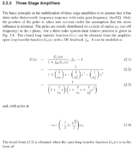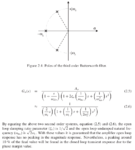promach
Advanced Member level 4
As in section 2.2.3 of View attachment phd_jramos.pdf , I have few questions:
1) Why assume "third order Butterworth frequency response with unity gain frequency" ?
2) Why negative DC feedback ?
3) How do we obtain expression (2.2) from (2.1) ?
4) How do we obtain the expression of open loop undamped natural frequency response, ωno as (sqrt(2) * ωc)?
5) Could anyone elaborate more on "a peaking around 10 % of the final value will be found in the closed loop transient response due to the phase margin value." ?


1) Why assume "third order Butterworth frequency response with unity gain frequency" ?
2) Why negative DC feedback ?
3) How do we obtain expression (2.2) from (2.1) ?
4) How do we obtain the expression of open loop undamped natural frequency response, ωno as (sqrt(2) * ωc)?
5) Could anyone elaborate more on "a peaking around 10 % of the final value will be found in the closed loop transient response due to the phase margin value." ?


Last edited: